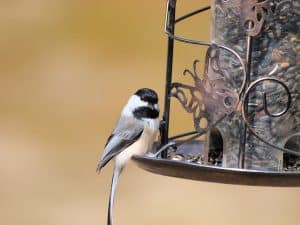
What is your favorite bird? Many of us would answer, “Chickadee!”
After all the black-capped chickadee is the Massachusetts state bird. Chickadees’ cheerful presence at our bird feeders or in the trees along our walk, is always welcome. Its range is confined to North America, from the northeast to northern California and south to the southern Appalachians. Chickadees are non-migratory.
Cornell Laboratory of Ornithology’s Project Feeder Watch reports that the black-capped chickadee is our most often observed feeder bird. It is reported at 97% of the feeders being watched by citizen scientists in New England and Canada. Chickadees seem always to come out on top of the most-seen list, and populations have been quite stable in the past 31 years; the time period that Project Feeder Watch has been in operation.
Cornell reports that chickadee winter flocks comprise three to twelve individuals, usually a resident pair and several unrelated juveniles. The resident pair, which mates for life, is dominant over the flock and secures the best access to food. The pair’s experience and knowledge of their territory is of paramount importance to the juveniles. Many other species of birds also flock with chickadees to find the best sources of food. Winter bird feeding can help them. Project Feeder Watch reports, “Studies showed that….if temperatures dropped below zero for more than five days in a row, chickadees that were able to visit feeders fared better than birds without a food supplement.” [Kerrie Wilcox, Project Feederwatch, Winter Bird Highlights 2017-18, page 7.]
Willcox reports that chickadees live an average of 2.5 years, and that an occasional hearty or lucky individual may live up to 12 years. Their winter diet is about half insects and spiders, and half seeds and berries. They may collect up to seventy seeds in a day. Many of these they cache for later, and they remember where their seeds are hidden. Chickadees have a remarkable memory, remembering not only where they hid food, but also which hiding spaces they have already emptied. On cold winter days, they must consume 10% extra calories in order to make it through the night. They hide in small holes, go into a hypothermic state, which lowers their body temperature, and shiver throughout the night to stay warm. Aren’t we lucky we don’t have to do that?
Many thanks to all flora and fauna reporters for the month of February. Please send reports by February 26 to be included in the next column. You can write me at 7A Old Colony Drive, call me at 692-3907, or e-mail me at mariancharman@gmail.com
**editors note: Check out this very cool YouTube video – 8 Black-capped Chickadee Calls Explained by LesleytheBirdNerd – https://bit.ly/39A2EoZ
__________________________
Late January Reports:
Esther Donlon, Providence Rd. January 20, “My wildlife camera has picked up several shots of coyotes and one little possum. Also what may be a fox.”[Esther sent some good photos-MH]
Marian/Bill Harman, Old Colony Drive. January 24, Tracks in snow: bobcat, fisher, coyote, deer. January 27, 36 degrees, eight juncos, two chickadees, two goldfinch, a white-breasted nuthatch, a blue jay.
February Reports:
Rosemarie Koester, Providence Road. February 2, a big buck passing through our back yard. February 13, heard an owl, think it was a barred owl. February 25, three male red-winged blackbirds. Several pairs of blue jays, several pairs of cardinals, house finches, goldfinches, purple finch, junco, large flock of grackles-“they really eat a lot of seeds!” Song, chipping and field sparrows, a few turkeys off and on, three playful squirrels, chipmunks came out about mid-February, paw prints in snow, might be a bobcat.
Marian/Bill Harman, Old Colony Drive. February 3, a walk on the trail, 43 degrees. Pileated woodpecker flew overhead, chickadees, jays, titmice, white-breasted nuthatch, mourning dove, large owl pellet on the ground with grey fur and two rodent incisors embedded in it. The lady fern is flattened out but is still bright green, emerald mosses. February 6, snow and sleet, thirty degrees. At feeder: Carolina wren, two chickadees, five juncos, two goldfinches, one American tree sparrow, a downy woodpecker, a white- throated sparrow, one cardinal, one blue jay. February 10, rainy, 36 degrees. A chickadee hit the glass slider. It landed upside down on the deck, unconscious, breathing heavily. I put it in a box in the warm downstairs bathroom, and it came to a little. It righted itself and sat on its chest, but didn’t stand and was obviously concussed. We put holes in the tightly fitted cover and left it to rest with water and food. We had to go out 2-9 p.m. When we got home, expecting to see it had died, we saw with a mixture of happiness and horror that the bird had enlarged a hole in the box top and escaped. We found it upstairs clinging to a screen in the den, all fluffed out and in deep sleep. We closed the door and let it sleep. The next morning it was wide awake and trying to peck a hole in the screen. I took off the screen and opened the window. It was confused, but allowed me to gently catch it and release it outside. Luckily it was a sunny, warm day. It flew easily to a nearby tree–Yay! February 17, a walk on the Pilgrim Village land: a beautiful male pileated woodpecker was flying all around the woods calling loudly. Coyote and fisher tracks seen. February 25, red-winged blackbirds calling on Court Rd. February 27, first grackle seen at our feeder. One of our goldfinches seemed to be having difficulty flying. Closer inspection revealed that it had the eye disease which afflicts some finches. One eye was completely closed and the other was only half open. Poor thing. We will have to disinfect or replace the feeder it was using, as this disease can spread to other birds.
Barbara Theriault, Tadmuck Lane. February 6, red-bellied woodpecker at suet. February 5-12, cardinals, titmice, chickadees, Carolina wren, juncos, downy and hairy woodpeckers. February 17, “a parade of a dozen deer walking in the woods about 20 yards out from the house.”
Ron Gemma, Concord Rd. February 24, red-tailed hawk in the yard–had a good view of the plumage, including the red tail. I also spooked one yesterday from a tree while walking along Concord Road near Rt. 111. “I was able to see the whitish underbody and was also treated to a loud screech.”
Debbie Prato, Hayrick Lane. February 24, Canada geese, starlings, grackles, red-winged blackbirds, flicker heard, opossum and skunk roaming around yard in daytime, red and gray foxes.
Marian Harman is a member of the Westford Conservation Trust, a non-profit conservation organization whose purpose is the preservation of Westford’s open spaces and trails. The Trust welcomes new members and volunteers. Check out our website at westfordconservationtrust.org, and visit us on Facebook.
